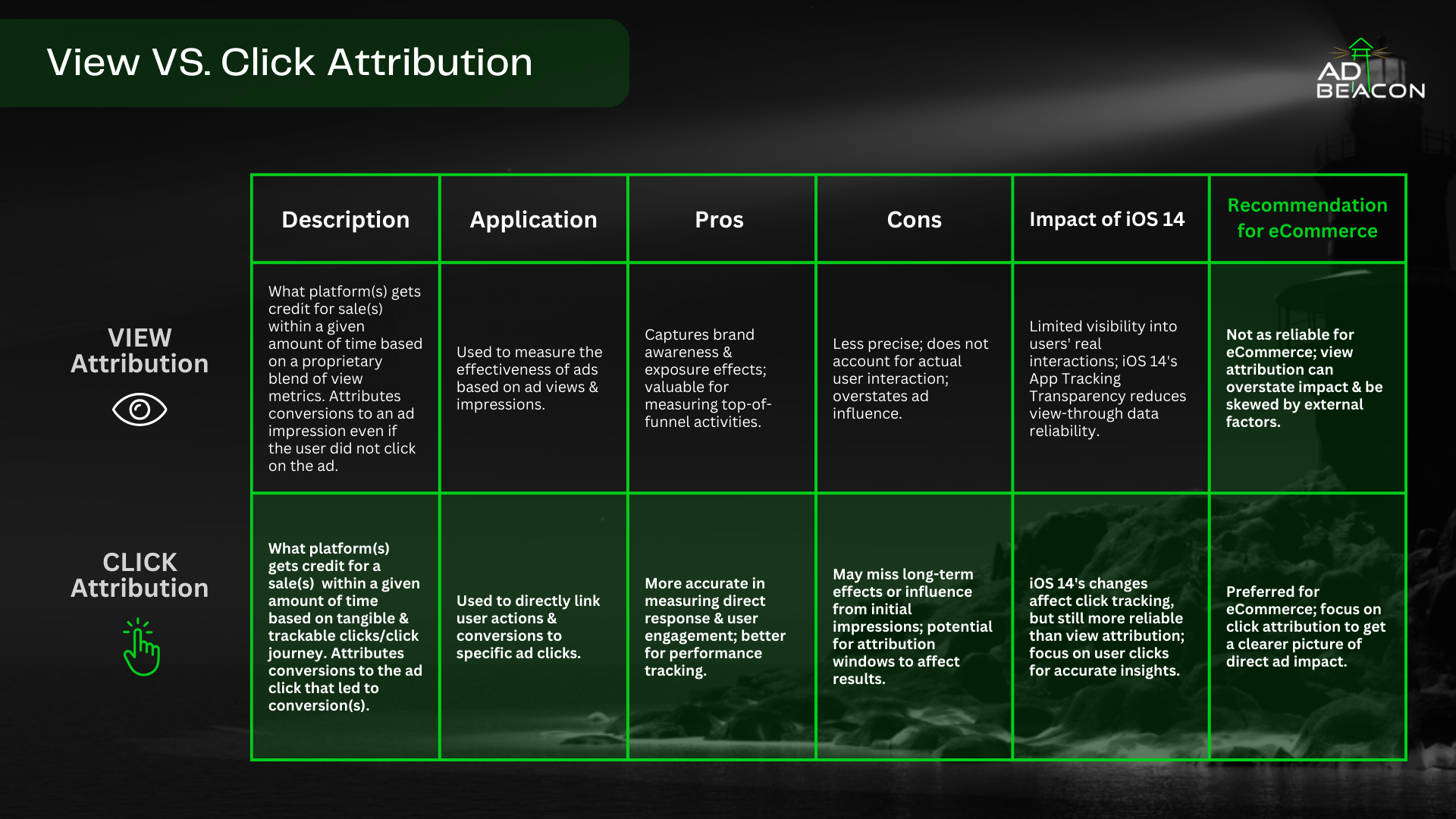In a world full of acronyms and complex language, terms like attribution can be daunting. Our goal is to demystify attribution, ad tracking, and the world of data privacy.
Understanding how your advertisements contribute to sales is crucial for optimizing your marketing efforts – which brings us to attribution.
What is attribution?
Simply, who or what platform/channel gets credit for a conversion within a given amount of time.
Two primary methods of measuring ad effectiveness are view attribution and click attribution. Each has its own set of advantages and challenges. Today, we will compare these two attribution models to help you decide which one is best for your eCommerce strategy.
What is View Attribution?
View attribution credits a sale to an ad impression within a given amount of time, even if the user did not click on the ad. This method uses a proprietary blend of view metrics to attribute conversions.
Here’s an example: A user sees an ad for a new pair of shoes on a social media platform but does not click on it. A few days later, they visit the website directly and make a purchase. View attribution gives credit to the initial ad impression for the sale.
Application: Used to measure the effectiveness of ads based on ad views and impressions.
Pros:
- Captures Brand Awareness: Measures the impact of brand exposure and awareness, which is valuable for top-of-funnel activities.
- Exposure Effects: Helps understand how ads contribute to brand recall and interest, even without direct interaction.
Cons:
- Less Precise: Does not account for actual user interaction, making it less precise.
- Overstates Ad Influence: Can overstate the influence of ads by not differentiating between viewers who saw the ad and those who interacted with it.
Impact of iOS 14: The introduction of iOS 14’s App Tracking Transparency has reduced the reliability of view-through data by limiting visibility into users’ real interactions.
Recommendation for eCommerce campaings: View attribution is not as reliable for eCommerce due to its tendency to overstate the impact of ads and be skewed by external factors.
What is Click Attribution?
Click attribution credits a sale to an ad click within a given amount of time. This method tracks tangible and trackable clicks and click journeys to attribute conversions. Attribution based on tangible clicks give us a more accurate “through line” from the beginning to the end of the purchase journey.
For example: Imagine a customer clicks on an ad for a smartwatch, visits the website, and makes a purchase. Click attribution gives credit to the ad click that directly led to the sale.
Application: Used to directly link user actions and conversions to specific ad clicks, making it better for performance tracking.
Pros:
- More Accurate: Provides a more accurate measure of direct response and user engagement.
- Better for Performance Tracking: Ideal for understanding which ads are driving conversions.
Cons:
- May Miss Long-Term Effects: Could miss the influence of initial impressions if the user does not click immediately.
- Attribution Window Impact: The timeframe for tracking clicks can affect the results, potentially missing delayed conversions.
Impact of iOS 14: Although iOS 14’s changes affect click tracking, it remains more reliable than view attribution. Focusing on user clicks provides more accurate insights.
Recommendation for eCommerce: Click attribution is preferred for eCommerce as it offers a clearer picture of direct ad impact, allowing for better optimization of marketing spend.
Why Click Attribution is Better for eCommerce
Click attribution provides a direct link between an ad and a conversion, making it a more reliable method for eCommerce businesses focused on performance and ROI. Here’s why click attribution is advantageous:
- Precision in Tracking: Click attribution tracks user interactions more precisely, offering clearer insights into which ads are driving sales.
- Enhanced Decision-Making: With accurate data on ad performance, businesses can make informed decisions about where to allocate their marketing budget.
- Adaptability: Despite the challenges posed by iOS 14, click attribution remains adaptable and continues to provide valuable data for optimizing ad campaigns.
- Focus on Engagement: Click attribution ensures that only ads that generate user engagement are credited, leading to a more accurate assessment of ad effectiveness.
Attribution - Without Assumptions
While both view and click attribution have their roles in measuring ad effectiveness, click attribution stands out as the more reliable choice for eCommerce businesses.
It offers precise tracking, better decision-making capabilities, and a focus on direct user engagement, all of which are crucial for maximizing marketing ROI.
Our platform is designed to harness the power of click attribution, providing eCommerce businesses with the tools and insights needed to optimize their ad campaigns effectively. By leveraging AdBeacon’s advanced attribution models, you can ensure your marketing efforts are data-driven and highly effective.
For eCommerce businesses looking to optimize their marketing strategies, focusing on click attribution with AdBeacon can provide the clarity and precision needed to drive better results. Explore how AdBeacon can enhance your ad tracking and performance analysis today.
